Archive \ Volume.11 2020 Issue 3
Simultaneous Determination of Oxazepam and Clomipramine by Continuous Wavelet and Derivative Transforms
Ruhollah Dastaran 1, Ali Sheibani 1*, Masoud Reza Shishehbore 1, Hamid Saeedi-Sourck 2
1 Department of Chemistry, Yazd Branch, Islamic Azad University, Yazd, Iran. 2 Department of Electrical Engineering, Yazd University, Yazd, Iran.

Abstract
In this study, different types of mother wavelets from continuous wavelet transform (CWT) methods were proposed for simultaneous determination of oxazepam (OXA) and clomipramine (CLO) which are used to treat anxiety and major depressive disorder, respectively. For this purpose, the first derivative spectra obtained from overlapping absorption spectra were processed by various mother wavelets. Sym8, meyer, gaus5, and db6 were found to be appropriate for processing of the derivative UV spectra. To evaluate the performance of the proposed methods, the analytical validation parameters were investigated through the analysis of synthetic binary mixtures from two drugs. Calibration graphs in the linear concentration ranges of OXA (10-50 µg/mL) and CLO (12-25 µg/mL) were obtained (r>0.991). The capability of the proposed CWTs was also tested which gave good satisfactory results.
Keywords: Mother Wavelets, Continuous Wavelet Transform, Simultaneous Determination, Oxazepam, Clomipramine, First Derivative Spectra, Binary Mixtures
INTRODUCTION
Oxazepam (OXA) and clomipramine (CLO) belong to benzodiazepine and tricyclic antidepressant class, respectively. OXA, 7-chloro-1,3-dihydro-3-hydroxy-5-phenyl-1,4(2H)-benzodiazepin-2-one, is a commonly used anxiolytic drug and ligand of the GABAA benzodiazepine receptor. Moreover, it is widely used as an antidepressive and sedative drug and also as a drug in anti-alcoholic therapy. [1-3] OXA is excreted in bile and urine in the form of glucuronide conjugates. [4] CLO is a typical tricyclic antidepressant with a wide clinical spectrum being used in major depressive, panic and obsessive-compulsive disorders. In spite of new atypical drugs such as those of the SSRI group (fluoxetine, fluvoxamine, etc.), CLO is still the reference compound in the treatment of this psychiatric disorder. [5-7] Many of the benzodiazepines are also used in combination with antidepressants in the management of depression. [8]
Determination of OXA and CLO with several analytical methods such as HPLC-DAD [9], voltammetry [10], HPTLC [11], LC [12], and simple spectrophotometry [13] have been developed. In this study, continuous wavelet transform (CWT) and derivative spectrophotometry (DS) methods were used for simultaneous determination of OXA and CLO in laboratory prepared mixtures. Wavelet transform (WT) methods are newer than the derivative method for signal processing and the most efficient signal analysis tools used today. [14,15] WT is a strong tool in spectral studies including signal de-noising [16], baseline correction,[17] and signal processing. Therefore, it can be applied as a powerful technique in analytical purposes. [18-21] CWT is fast, selective, sensitive and it provides a higher signal to noise ratio than the classical derivative approach.
The main goal of this study was simultaneous determination of two drugs OXA and CLO. A strong overlapping was seen between absorption spectra of OXA and CLO. Therefore, routine spectrophotometry is not suitable for simultaneous determination of these drugs. Based on the obtained results, the combined DS1 and CWT methods can effectively solve this drawback. [22, 23]
MATERIAL AND METHODS
The standard stock solutions of OXA and CLO were prepared by dissolving 10 mg of each drug in 100 mL of methanol. The calibration solutions of OXA (10-50 µg/mL) and CLO (12-25 µg/mL) were prepared from the stock solutions. In this study, all of absorption spectra and their first derivative spectra were recorded by shimadzu UV-160A double beam within range of 200-350 nm. After entering the derivative spectra information in the MS-Excel, these details were used to apply different CWTs in MATLAB software 9.3(R2017b). The commercial brands of SOBRIL (OXA 10 mg) and also ANAFRANIL (CLO 10 mg) were used for analysis.
THEORETICAL BACKGROUND
Wavelet transform method
WT is a powerful tool to process different signals in electrical engineering, chemistry and physics. In signal processing aspect, WT is a mathematical method that converts signals into various coefficients with different resolutions. CWT is defined as
 (1)
(1)
where f (t
(t ) is desired signal (time-domain function) and Ψa,b
) is desired signal (time-domain function) and Ψa,b (t
(t ) is the wavelet corresponding to scale parameter a
) is the wavelet corresponding to scale parameter a and translation parameter b
and translation parameter b as
as
 (2)
(2)
As shown in (2), parameter a plays the role of scale for mother wavelet Ψ
plays the role of scale for mother wavelet Ψ (t
(t ). In other words, increasing and decreasing scale parameter a
). In other words, increasing and decreasing scale parameter a expands and shrinks mother wavelet Ψ
expands and shrinks mother wavelet Ψ (t
(t ), respectively. According to (1), wavelet coefficients are calculated for different values of a
), respectively. According to (1), wavelet coefficients are calculated for different values of a and b
and b . Essentially, we fix scale parameter a
. Essentially, we fix scale parameter a to a desired value and calculate wavelet coefficients for different values of b
to a desired value and calculate wavelet coefficients for different values of b . By different scale parameters, wavelet coefficients are achieved for different resolutions. However, the various types of mother wavelets are designed with different properties. In this paper, we used some types of mother wavelets such as Symlet (sym8), Daubechies (db6), meyer and Gaussian (gaus5). In this paper, the capability of CWTs to extract data has been evaluated for simultaneous determination of OXA and CLO in combined formulation.
. By different scale parameters, wavelet coefficients are achieved for different resolutions. However, the various types of mother wavelets are designed with different properties. In this paper, we used some types of mother wavelets such as Symlet (sym8), Daubechies (db6), meyer and Gaussian (gaus5). In this paper, the capability of CWTs to extract data has been evaluated for simultaneous determination of OXA and CLO in combined formulation.
RESULTS AND DISCUSSION
Absorption spectra
In the present study, the absorption spectra of OXA (10-50 µg/mL) and CLO (12-25 µg/mL) were obtained in range of 200-350 nm (Figure 1). According to this Figure, the simultaneous determination of the drugs in their mixture by the classical absorbance measurement method is not possible due to the strong overlapping absorption spectra. Therefore, developing new methods such as DS and CWT is necessary to the quantitative resolution of them.
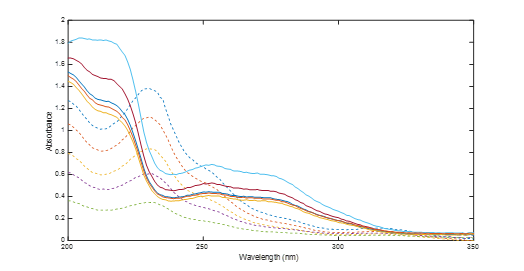
Figure 1 – The absorption spectra of OXA (----): 10, 20, 30, 40, 50 µg/mL and CLO (¾): 12, 14, 15, 20, 25 µg/mL.
Derivative Spectrophotometry (DS)
As mentioned before, OXA and CLO showed an overlap spectra, therefore; they cannot be analyzed using zero order absorption measurements. The DS method can find the concealed peak in initial absorption spectra and also provide the amplitude and suitable spectra shape. The combination of derivative and WTs increases the number of zero-crossing points as well as obtains a higher sensitivity and selectivity as compared to the original derivative or wavelet spectra.
In this study, DS1 for OXA and CLO was derived from the absorption spectra of two drugs. The DS1 spectra of OXA and CLO are shown in Figure 2. DS1 amplitudes at 240 nm (zero-crossing of CLO) and at 229 nm (zero-crossing of OXA) were chosen for simultaneous determination of OXA and CLO, respectively. The calibration graph and analytical parameters are shown in Table 2.
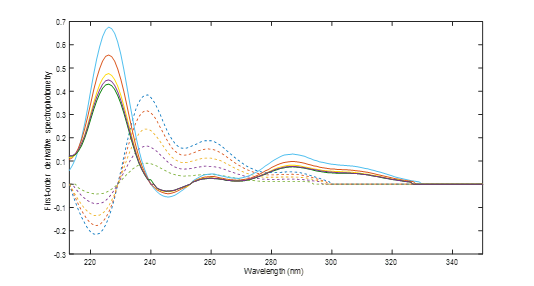
Figure 2 – First-order derivative spectrophotometry of OXA (----): 10, 20, 30, 40, 50 µg/mL and CLO (¾): 12, 14, 15, 20, 25 µg/mL.
Derivative Spectrophotometry-Continuous wavelet transform (DS-CWT)
CWT method is one of the most efficient signal processing technique for overlapping peak resolution and also for optimizing the derivative peaks which are obtained from absorption spectra. It has the advantage of signal amplification compared to DS method. So, expect that the combination of DS to CWT can improve the calibration graph and validation parameters in simultaneous determination purposes. After studying different CWT families to DS1 spectra, several mother wavelets (sym8, meyer, gaus5, db6), were selected for applying to DS1 in simultaneous determination of OXA and CLO at specified concentrations of binary mixtures. Figures 3-6 illustrate the DS1-CWT spectra of the standard calibration series for OXA and CLO. The zero-crossing points found in this method are reported in Table 1. Linear regression analysis and the corresponding statistical data for the developed DS1-CWT methods are summarized in Table 2.
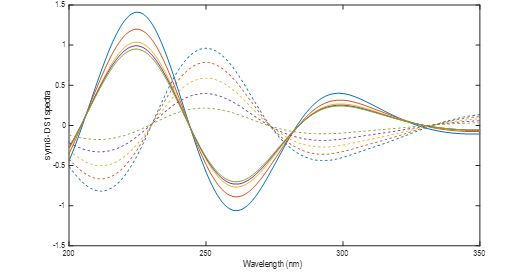
Figure 3 – Wavelet transform of first-order derivative spectra using sym8, OXA (----): 10, 20, 30, 40, 50 µg/mL and CLO (¾): 12, 14, 15, 20, 25 µg/mL.
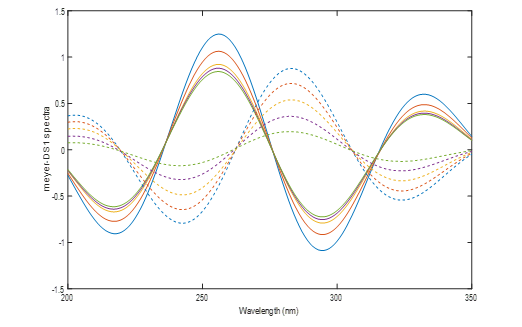
Figure 4 – Wavelet transform of first-order derivative spectra using meyer, OXA (----): 10, 20, 30, 40, 50 µg/mL and CLO (¾): 12, 14, 15, 20, 25 µg/mL.
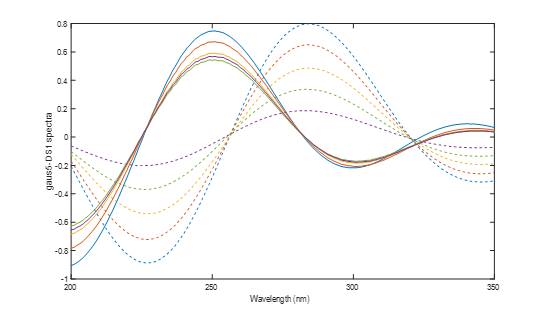
Figure 5 – Wavelet transform of first-order derivative spectra using gaus5, OXA (----): 10, 20, 30, 40, 50 µg/mL and CLO (¾): 12, 14, 15, 20, 25 µg/mL.

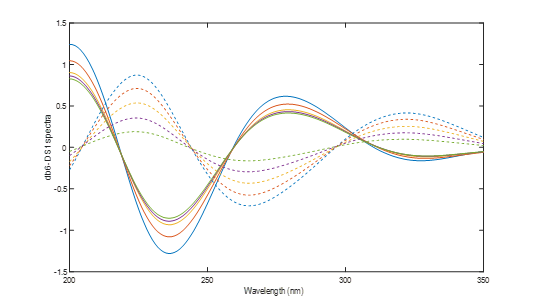
Figure 6 – Wavelet transform of first-order derivative spectra using db6, OXA (----): 10, 20, 30, 40, 50 µg/mL and CLO (¾): 12, 14, 15, 20, 25 µg/mL
|
Table 1- Zero crossing points found in DS1-CWT methods for simultaneous determination of OXA and CLO. |
||
|
Method |
Compounds |
Wavelength (nm) |
|
DS1-sym8-CWT |
OXA CLO |
243 230 |
|
DS1-meyer-CWT |
OXA CLO |
275 263 |
|
DS1-gaus5-CWT |
OXA CLO |
281 256 |
|
DS1-db6-CWT |
OXA CLO |
259 244 |
|
OXA: Oxazepam; CLO: Clomipramine; DS1: First-order derivative spectrophotometry. |
||
METHOD VALIDATION
Validation studies showed that the proposed DS1-CWT methods were successfully applied for determination of OXA and CLO in laboratory prepared mixtures. These methods were assessed by linearity, precision and accuracy. Assay results are presented in Table 2. A good linearity was obtained in the concentration ranges between 10-50 µg/mL for OXA and 12-25 µg/mL for CLO according to their correlation coefficients (r ˃ 0.991). By using the standard deviation (SD) based on the data of the samples and the components of line equation such as intercept and slope of the straight-line, limit of detection (LOD) and limit of quantitation (LOQ) were calculated that these parameters were suitable in DS1-CWT methods. In order to evaluate the application of the proposed methods, the analysis of 4 synthetic mixtures was performed. These results are reported in Table 3. It was indicated that the mean recovery results and the related RSDs provided by the DS1-CWT appeared to be similar or a little higher than those of DS1 method.
|
Table 2- Linear least square analysis and statistical results. |
||||||||||
|
Parameter |
DS1-sym8-CWT |
DS1-meyer-CWT |
DS1-gaus5-CWT |
DS1-db6-CWT |
DS1 |
|||||
|
|
OXA |
CLO |
OXA |
CLO |
OXA |
CLO |
OXA |
CLO |
OXA |
CLO |
|
l (nm) |
243 |
230 |
275 |
263 |
281 |
256 |
259 |
244 |
240 |
229 |
|
Range (µg/mL) |
10-50 |
12-25 |
10-50 |
12-25 |
10-50 |
12-25 |
10-50 |
12-25 |
10-50 |
12-25 |
|
m |
0.0168 |
0.032 |
0.014 |
0.0275 |
0.0151 |
0.0151 |
0.0124 |
0.0275 |
0.0072 |
0.0178 |
|
n |
0.0293 |
0.4104 |
0.0264 |
0.3671 |
0.0317 |
0.3364 |
0.0253 |
0.3598 |
0.0162 |
0.1556 |
|
r |
0.999 |
0.995 |
0.999 |
0.996 |
0.999 |
0.999 |
0.999 |
0.995 |
0.999 |
0.991 |
|
SE (r) |
0.0082 |
0.0256 |
0.0141 |
0.0050 |
0.0067 |
0.0074 |
0.0055 |
0.0044 |
0.0074 |
0.0044 |
|
SE (m) |
0.0002 |
0.0023 |
0.0004 |
0.0004 |
0.0002 |
0.0006 |
0.0001 |
0.0004 |
0.0002 |
0.0004 |
|
SE (n) |
0.0085 |
0.0434 |
0.0148 |
0.0086 |
0.0070 |
0.0126 |
0.0057 |
0.0075 |
0.0078 |
0.0075 |
|
LOD |
0.879 |
1.720 |
0.908 |
1.556 |
0.952 |
0.746 |
0.933 |
1.656 |
1.043 |
2.350 |
|
LOQ |
2.931 |
5.734 |
3.029 |
5.189 |
3.176 |
2.488 |
3.112 |
5.520 |
3.476 |
7.834 |
|
OXA: Oxazepam; CLO: Clomipramine; CWT: Continuous wavelet transform; m: Slope of the straight-line; n: y-intercept of the straight line; r: Correlation coefficient; SE: Standard error; LOD: Limit of detection; LOQ: Limit of quantitation; DS1: First-order derivative spectrophotometry. |
||||||||||
|
Table 3 - Recovery data of OXA and CLO in the synthetic mixtures by applying the signal processing developed methods. |
||||||||||||
|
Mixture (µg/mL) |
DS1-sym8-CWT |
DS1-meyer-CWT |
DS1-gaus5-CWT |
DS1-db6-CWT |
DS1 |
|||||||
|
OXA |
CLO |
OXA |
CLO |
OXA |
CLO |
OXA |
CLO |
OXA |
CLO |
OXA |
CLO |
|
|
10 |
15 |
103.4 |
96.5 |
97.4 |
98.3 |
97.5 |
101.3 |
96.3 |
102.3 |
98.3 |
99.8 |
|
|
20 |
20 |
101.6 |
97.3 |
100.9 |
99.6 |
99.6 |
102.4 |
100.8 |
97.9 |
102.1 |
96.5 |
|
|
15 |
5 |
98.5 |
100.2 |
102.4 |
101.3 |
98.2 |
99.8 |
101.3 |
99.7 |
101.8 |
101.2 |
|
|
20 |
10 |
100.9 |
98.9 |
100.1 |
100.7 |
100.2 |
100.3 |
98.5 |
100.4 |
99.3 |
102.3 |
|
|
mean |
101.1 |
98.2 |
100.2 |
99.9 |
98.8 |
100.9 |
99.2 |
100 |
100.3 |
99.9 |
|
|
|
SD |
1.75 |
1.43 |
1.81 |
1.14 |
1.07 |
0.99 |
1.99 |
1.57 |
2.28 |
2.18 |
|
|
|
RSD% |
1.73 |
1.45 |
1.80 |
1.14 |
1.08 |
0.98 |
2.00 |
1.57 |
2.27 |
2.18 |
|
|
|
OXA: Oxazepam; CLO: Clomipramine; CWT: Continuous wavelet transform; SD: Standard deviation; RSD: Relative standard deviation. |
||||||||||||
CONCLUSION
The analysis of OXA and CLO showed that the absorption spectra of two drugs had a strong overlap. In this study, DS or CWT methods and also the combined DS1-CWT were proposed and used for signal processing and finding the zero-crossing points. CWTs have many advantages over DS such as a more zero-crossing, amplification of peaks and improvement of signal to noise. Furthermore, applying CWTs on the derivative spectra improved the accuracy and precision with good satisfactory results for simultaneous determination of OXA and CLO without chemical separation.
ACKNOWLEDGEMENTS
This work was financially supported by Islamic Azad University (IAU), Yazd Branch, Yazd, Iran.
REFERENCES
- Garattini S. Biochemical and pharmacological properties of oxazepam. Acta Psychiatr. Scand. Suppl, 1978; 274: 9–18.
- Lader M. H. The clinical pharmacology of oxazepam. Acta Psychiatr. Scand. Suppl, 1978; 274: 89–93.
- Peppers M. P. Benzodiazepines for alcohol withdrawal in the elderly and in patients with liver disease. Pharmacotherapy, 1996; 16: 49–57.
- Douse J.M.F. trace analysis of benzodiazepine drugs in blood using deactivated amberlite xad-7 porous polymer beads and silica capillary column gas chromatography with electron capture detection, journal of chromatography, 1984; 301: 137-15
- Insel T.R, Zohar J. in: Meltzer H.Y (Ed.). The Third Generation of Progress, Psycho pharmacology Raven Press New York 1987: pp. 120
- Zohar J, Insel T.R. Drug treatment of obsessive-compulsive disorder. J. Affect. Disord, 1987; 13 (2): 193-202.
- Thoren P, Asberg M, Bertilsson L, Mellstrom B, Sjoqvist F, Traskman L. Clomipramine treatment of obsessive-compulsive disorder: II. Biochemical aspects. Arch. Gen. Psychiatry, 1980; 37 (11): 1289-1994.
- Paumier K. L, Siderowf A. D, Auinger P, Oakes D, Madhavan L, Espay A. J. et al., Parkinson Study Group Genetics Epidemiology Working Group. Tricyclic antidepressants delay the need for dopaminergic therapy in early Parkinson's disease. Movement Disord, 2012; 27 (7): 880–7.
- zheng F, shi G. Simultaneous determination of clomipramine and four benzodiazepines in human plasma by HPLC-DAD after solid phase extraction. Chinese Pharma Bull, 2015; 31(4): 582-585.
- Tyszczuk K. Determination of Diazepam, Temazepam and Oxazepam at the Lead Film Electrode by Adsorptive Cathodic Stripping Voltammetry. Electroanalysis, 2010; 22 (17-18): 1975 – 1984.
- Koba M, Koba K, Ba˛czek T, Determination of Oxazepam in Pharmaceutical Formulation by HPTLC UV-Densitometric and UV-Derivative Spectrophotometry Methods. Anal Lett, 2009; 42: 1831–1843.
- Westenberg H.G.M, Drenth B.F.H, De zeeuw R.A. Determination of clomipramine and desmethylclomipramine in plasma by means of liquid chromatography. J. Chromatogr, 1977; 142: 725-733.
- Ali Ahmed E.A, Adawy M, El-Shahat M.F, S. Amin A. Simple spectrophotometric methods for determination of fluoxetine and clomipramine hydrochlorides in dosage forms and in some post-mortem biological fluids samples. Egypt. J. Forensic Sci, 2016; 6 (4): 370-380.
- Daubechies I. Ten lectures on wavelets. Society for Industrial and Applied Mathematics, Philadelphia; 1992.
- Walczak, B, Wavelets in chemistry, Amsterdam Elsevier Press 2000.
- Gao L, Ren S. Multivariate calibration of spectrophotometric data using a partial least square with data fusion. Spectrochim. Acta, Part A, 2010; 76 (3-4): 363-368.
- Ma X.G, Zhang Z.X. Application of wavelet transform to background correction in inductively coupled plasma atomic emission spectrometry. Anal. Chim. Acta, 2003; 485 (2): 233-239.
- Ehrentreich F. Wavelet transform applications in analytical chemistry. Anal. Bioanal. Chem, 2002; 372 (1): 115-121.
- Shao X.G, Leung A.K.M, Chau F.T. wavelet transform. Acc. Chem. Res, 2003; 36: 276-283.
- Jetter K, Depczynski U, Molt K, Niemoller A. principles and applications of wavelet transform to chemometrics. Anal. Chim. Acta, 2000; 420: 169-180.
- Dinc E, Baleanu D, Tas K (editor). Mathematical Methods in Engineering Springer Amsterdam 2007: pp 265.
- Alsberg B.K, Woodward A.M, Kell D.B. An introduction to wavelet transforms for chemometricians: A time-frequency approach Chemom. Intell. Lab. Syst, 1997; 37 (2): 215-239.
- Leung A.K.M, Chau F.T, Gao J.B. A review on application of wavelet transform techniques in chemical analysis. Chemom. Intell. Lab. Syst, 1998; 43: 165-184.
